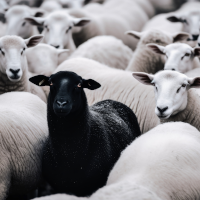Did You Find Out? Get the Answer to the Riddle of E-News Issue No. 3, July 2024
Black and White

A farmer only keeps sheep and horses on his farm. All his animals are either white or black. He has 60 black horses, 100 white animals, and twice as many sheep as horses. 120 animals are either black or horses, but not black horses.
How many animals live on the farm?
Solution
If the farmer has twice as many sheep as horses and H is the number of horses, the farmer has 2H sheep and therefore a total of 3H animals. The 120 animals that are either black or horses, but not black horses, can only be black sheep or white horses. If BS is the number of black sheep, then there are 120 – BS white horses and 60 + BS black animals.
The farmer therefore has a total of 3H = 100 + 60 + BS animals, where 100 is the number of white animals, 60 is the number of black animals, and BS is the number of black sheep. In addition, the following equation results for the number of horses: H = 120 – BS + 60, i.e., the number of horses is equal to the number of white horses plus the number of black horses.
If you add the two equations together, SS falls out and you get H = 85. So there are 3H = 255 animals living on the farm.








 +47 3557 3800
+47 3557 3800